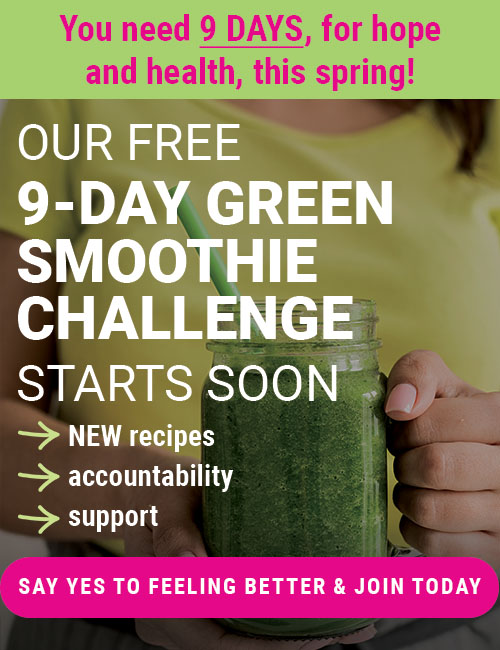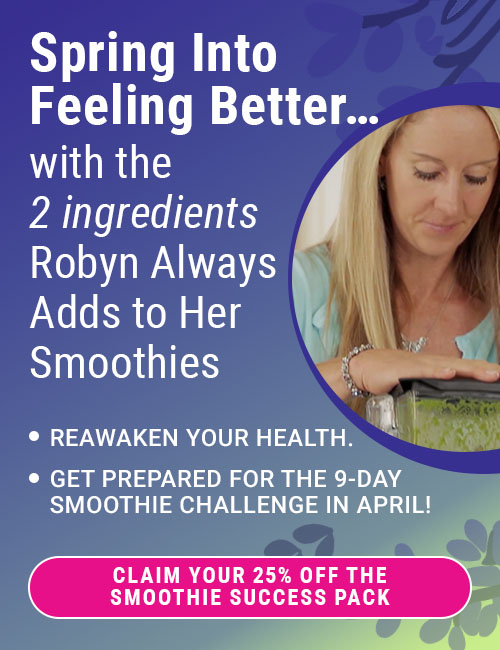Fermenting foods: it’s freaking me out!
Dear GreenSmoothieGirl: I really like the idea of adding the Rejuvelac as my green smoothie base, but I’m honestly totally freaked out to leave something perishable on my countertop in an unsealed container for several days. What are the chances that “bad bacteria” get in there and make me sick? I really appreciate any feedback you have. It sounds like a great opportunity to make green smoothies do even more for me, but I can’t get over the initial concept. –Grace
Answer: Grace, I think it might help if I explain the concept a bit more. Fermented foods are part of your diet already, if you eat yogurt or sauerkraut, or even beer. The manufacturer had to let it sit at room temperature for a time, to grow the cultures.
Also, before refrigeration, human beings had a stronger inner terrain and microbes rarely harmed them. Of course, now we have antibiotics that have seriously damaged most people’s balance of beneficial microorganisms colonizing the digestive tract. We also have refined foods weakening us, and few, if any, cultured foods strengthening us. We now seem to believe that killing a couple million of the billions of microscopic critters around us will somehow do the trick.
It’s a weird modern concept that everything we eat has to be sterilized—ancient peoples lived amongst billions of organisms very peacefully for thousands of years. So maybe our food is sterilized, fumigated, pasteurized, irradiated…..but there are billions of organisms everywhere ELSE (which makes the antibiotic wipes a pointless waste of money).
So, it feels unnatural to you but only because of our strange modern traditions, and the fact that we’ve gotten away from eating foods that nurture our gut’s need for healthy colonization. Just ONE course of antibiotics can change the gut’s internal terrain forever.
Every culture of the world eats cultured foods. Some chew up a food and spit it, with their saliva, into an earthen pot, and drink it a week later. (I won’t be teaching you those methods, don’t worry.) There are literally hundreds of types of cultured foods, in traditional / indigenous peoples, and in people who have not completely adopted processed diets.
The most complete and well known work on this concept is Sally Fallon’s Nourishing Traditions, which has some good info but advocates for lots of meat and dairy and a very rich diet. My 12 Steps to Whole Foods program deals with it in a condensed way in Ch. 8 and uses what I feel are a do-able, moderate amount of probiotic foods that do not require us to purchase $10/lb. animal parts. My work focuses on culturing vegetables, optionally some raw, antibiotic- and hormone-free milk, or coconut liquid. (I now culture my coconut liquid before using it in Hot Pink Breakfast Smoothie).
My blog on 9/15 talks about learning vicariously through others—the examples I gave were learning from others’ health disasters. But you can learn from my health victories, too. Does it help you to know that I have had a quart or a half gallon of raw kefir, or yogurt, or coconut kefir, or sprouts, or Rejuvelac, or sauerkraut, on my counter, pretty much every day of my life for the past 17 years? We have had zero instances of problems, illness, food poisoning.
It also helps if you understand the process of how food has historically been preserved. You can preserve foods a few ways. One, drying it to dramatically slow oxidation, which often involves lots of salt. Two, can it by killing all its lifeforce (enzymes and vitamins) so that there’s very little to oxidize, and then sealing it against air and bacteria. Third, utilizing lactobacillus and other beneficial organisms and lactic acid to break down the proteins and preserve the food (fermenting).
The way I make sauerkraut (see Ch. 8 of 12 Steps) is that the unrefined salt preserves it for a few days while the (slower) lactic acid begins to take over. I have two-year old raw sauerkraut (that I preserved with whey from my yogurt/kefir) that has been unsealed (but covered tightly with a lid) that we are still eating. It’s too soft, and it’s better, texture-wise, at six months old. But it’s preserved, and the healthy bacteria help my family stay healthy.
It might help to address the semantics. The word “fermented” has a negative connotation. (Although beer drinkers who wouldn’t be caught dead eating fermented vegetables drink PLENTY of fermentation.) When you think of fermented, do you think of ROTTEN? We aren’t eating any rotten foods at my house. We could mentally replace that word with a much nicer one: cultured!
So, don’t eat fermented foods. Eat cultured ones!
If “bad” bacteria gets into your cultured foods and makes them “go bad,” you will know. They will taste bad and/or mold. I have almost never had this happen. Once it happened with a bottle of sauerkraut. Never with kefir or Rejuvelac.
My Rejuvelac ferments in a day. At CHI, they told me 3-5 days, but mine tastes plenty tart 24 hours after I blend the sprouts and water, and put it on the counter to grow (aka ferment, aka culture).
Here’s my new video showing this easy, inexpensive habit that has the potential to see you through the winter without viruses or infections!
Posted in: 12 Steps To Whole Food, Videos, Whole Food














Thanks for posting the video! I am interested in making Rejuvelac using quinoa, now I know how to do it. I’m wondering if one could make saurkraught and other fermented recipes using Rejuvelac instead of whey from yogurt or kefir. Anyone ever try this?
Can you use any variety of wheat? Your video only mentioned soft white wheat, but I have LOADS of stored hard red winter wheat and hard white wheat. Thanks for the tip. I’ll be sure to try this!
I was so excited to try making rejuvelac after watching your CHI videos, as I’ve been wanting to try making Kefir but haven’t found the grains. I need tips for those of us living in very HOT & HUMID climates. So last wk I experimented making rejuvelac using rye berries, followed all directions, only let it ferment about a day & half though b/c it was starting to smell. I did go ahead & drink some of the first batch, taste wasn’t great & had a terrible stomach ache & other tummy issues all that afternoon/evening. Next day I was brave & tried drinking some from the 2nd pour off b/c that didn’t smell as bad and did have the “slight lemony” smell…still wasn’t thrilled, but my stomach didn’t hurt as bad as day before. Decided to dump all and now I’m scared to try again.
jen, maybe if it’s really hot where you are, ferment it in the fridge. Let me know what happens! Or just “ferment” it for 12 hours, then refrigerate!
how long will the quinoa rejuv keep in the frig?
Polly, I don’t know as I’m experimenting, too, but it’s lasted several days for me but gets a bit stronger and more tart over time of course.
Thank you Robin! You have just made something that I thought would be hard into something I now know I can do. And putting it into my green smoothies is a great idea.
I tried making the Rejuvelac with soft white wheat berries. I couldn’t even stomach the smell let alone drink it. I tasted it even though the smell was totally wretched. It was not something I could stomach. Did I do something wrong? Is it supposed to smell like dirty rotten socks from my boys athletic bag? Also I have another question… How much cultured stuff should we have a day? I’m drinking homemade water kefir and kombucha and eating sourkrout and sometimes kimchi. My breakfast is a green smoothie and my lunch is a big green salad. For dinner i will eat something cooked that is vegetarian. BUT… I’m not going to the bathroom like I eat a lot of fiber and drink a lot of water. Unless I take a probiotic pill and a magnesium supplement. Do you have any suggestions?
Jennifer, see my blog posts on elimination, constipation, etc. Smelling like dirty rotten socks….um, no, mine doesn’t smell anything like that. In a rare case, a fermented food can go bad when bacteria gets a hold before lactic-acid fermentation does. Throw it away. But don’t give up, because I wonder if something else was going on—too hot in the kitchen, some fungus/yeasts in the air, something like that?
I love all your videos. It helps me feel like I can do what you are doing. I totally took my blendtec on our 6 month adventure to D.C. (staying in a hotel) and have enjoyed making my green smoothies to help counter the social hour dinners served most nights and inevitable eating out (way too many yummy restaurants available). We do what we can right?
Very useful info on how to make Rejuvelac! Thanks for posting this. Will try using this as the base for my green smoothies.
My husband worries that one of the by products of fermentation is alchol is this true? We refrain from alcohol and we would really appreciate knowing that when we eat or drink these cultured foods they are good for us and won’t make us drunk. 🙂
It will definitely not make you “drunk,” could have up to 0.0025 alcohol, whereas beer has .04 to .06 alcohol, if that gives you any idea how little there is.
I have been doing something similar to Rejuvelac since I was diagnosed with cancer in 2009. I make kombucha using various kinds of teas. Kombucha is a fermented tea product that is able to help remove some of the chemicals from chemo from the body! It is not as inexpensive as rejuvelac, but since it’s made with tea (green tea is my favorite), it does give all the benefits of tea, as well. It tastes a little like vinegar, but I like to add fresh juices to up the nutrition. (My husband, who HATES vinegar, says he’s addicted to kombucha!)
Thanks for all you do to keep us healthy, Robyn!!
Stephanie, I added directions on making kombucha to the updated version of 12 Steps—it’s good but I’m not convinced that all the sugar added is “consumed” by the microorganisms doing their work. So I prefer other things, but I drink kombucha sometimes too—it’s like a treat.
Robyn, I made some of the drink and added it to my smoothies and you are so right…I could NOT tell a difference in the taste!! Thanks for demonstrating how to make it. It gave me the courage to try it myself since it looked so simple.
Thanks, Robyn! I will try it. My raw goat milk source for my kefir dried up, literally, and I’ve been worrying over what to do about it. I know I’ve got some quinoa that nobody liked — I’ll have to try that first.
Do you have to rinse the quinoa really well first, to remove the bitterness?
Moyne, no, just soak the quinoa and drain the water, then you’ll be rinsing it twice a day…..no danger of the quinoa being bitter.
I am avoiding eating wheat.
Are the wheat berries OK for this or should I use the Quinoa instead?
Thank you,
Sita
Sita, this being a new habit for me, my data is limited thus far. Wheat, of course, has gluten. However, the sprouting and fermenting is breaking down the proteins so that even gluten-intolerant people may find it very tolerable. I do not have a noticeable gluten sensitivity; however, I have found the wheat Rejuvelac, thus far, slightly mucous forming, and the quinoa Rejuvelac is not mucous-forming at all! It’s more expensive but perhaps a better idea if you have any concern about gluten.
Thank you for the great video and ideas!
Quick question:
When you finished blending the quinoa, it looked like you further diluted it with water by pouring the mixture into jars that already had water in them.
Did I see that right? Do you need to dilute it or can you use it full strength?
Thanks in advance!
Melodie, I did do that! 1 cup of dry wheat resulted in a GALLON of Rejuvelac.
Robyn,
Do you still drink kefir everyday too or is having the rejuvelac in the smoothie now enough probiotics for the day? Is it even possible to get too much fermented/cultured foods in your diet? I have been doing the rejuvelac for the past week or so and my kids don’t notice the difference either and it is so easy and fun to know that I’m making it even healthier than it was already. I’m just wondering if it’s best to keep up both habits (kefir and rejuvelac) or alternate or what. Thanks for all you do.
Sue, I’m doing both! Donna Gates convinced me to do MORE cultured foods than I was doing. She claims that the probiotic microorganisms will consume some of the sugars you eat, if you eat a bit of refined/simple sugars. Not a license to go crazy with sugar—and I’m not eating ANY of it in the next year, as I believe you know—but a fun thought!